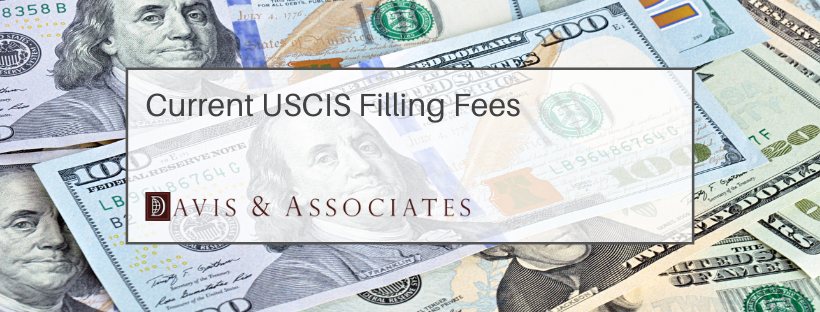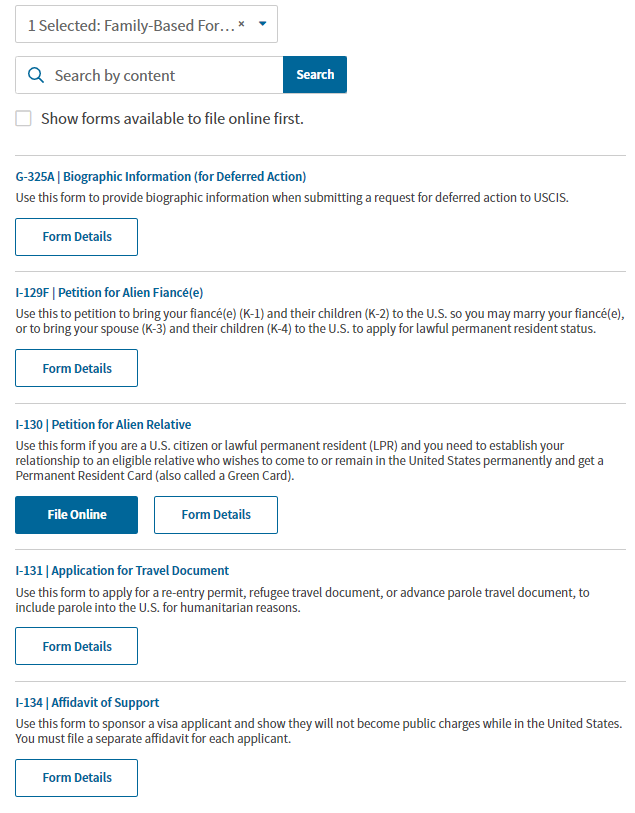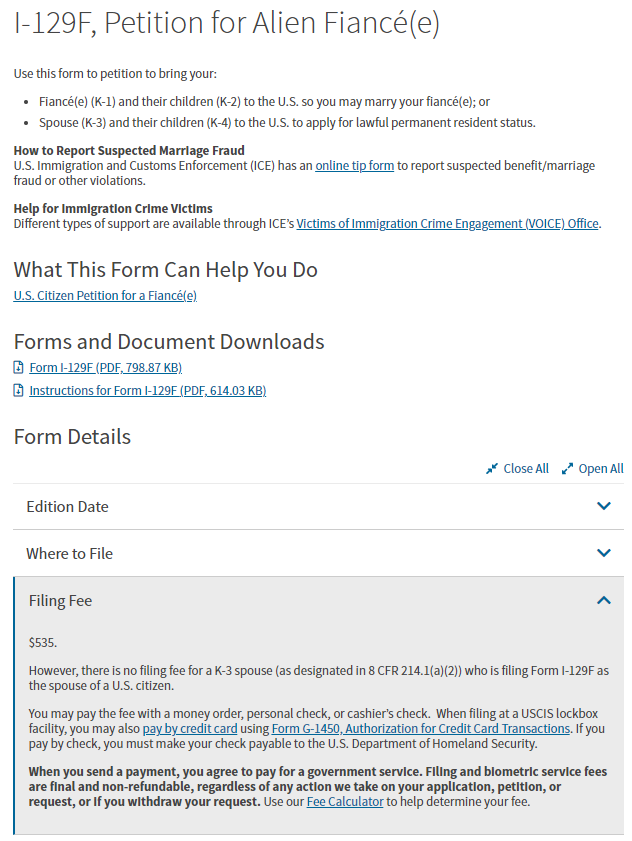
Current USCIS Application Fees
The United States Citizenship and Immigration Services periodically adjusts its application fees. Often, fee changes take place at the beginning of the next fiscal year, which begins in October.
However, that’s not always the case. Because these fees are subject to change, it’s best to check with the USCIS website to determine the current filing fees for any petition you want to file. Your Dallas immigration attorney can also help you determine the fees for the forms you need to complete.
The current filing fees by PDF on USCIS is here.
How to Use the USCIS “All Forms” Page to Determine the Filing Fees for Your Application
Follow these steps to determine the filing fees for your application using the USCIS website.
-
-
- Visit this page to determine how much it costs to file a particular form. You can filter the forms by category using the drop-down menu at the top of the page, as shown in the image below.

-
- Scroll until you see the form you need. Click “Form Details,” which you can see in the image below.

- On the form’s page, scroll until you see “Filing Fee.” Click the small downward-pointing arrow to open the box, which contains the form’s filing fee. Check out the image below to see a sample form’s page.

The filing fee on this particular form is $535, and the text continues to explain a situation in which there is no filing fee, as well as how you can pay your fee.
How to Pay USCIS Filing Fees
The way you pay your USCIS filing fees depends on where you’re located. The process is different if you’re inside the United States than it is if you’re abroad. That includes the way you pay for biometric services fees and other fees, as well.
Paying USCIS Filing Fees if You Live in the United States
You should always check the USCIS website for its most current filing fees, as well as to find out whether you may qualify for a waiver or one of your documents doesn’t require a fee. If you live in the United States, you may pay your fees – depending on the specific form you’re filing – by:
- Using a credit or debit card, or by bank withdrawal, online
- By mail with a credit or debit card number, check or money order
- In-person at any USCIS field office
Paying USCIS Filing Fees if You Live Outside the United States
If you live outside the United States, you still need to check the USCIS website for its most current filing fees. You may pay your fees depending on the requirements of the international USCIS office you’re using, or contact the U.S. embassy or consulate you’ll visit for information on how you can pay your USCIS fees.
How Do You Make out a Check to USCIS?
If you use a personal check to pay your USCIS fees, your checks must be pre-printed with your name and your bank’s name. Your address and phone number must also be on the check, but they may be pre-printed, typed, or written in ink.
Make the check out to U.S. Department of Homeland Security. (The agency warns people not to write USDHS or DHS.) Fill out the rest of the check as you normally would, but in the “For” or “Memo” line, write the purpose of your payment. For example, you may write N-400 application and biometric services fee or something similar.
What Credit Cards Does USCIS Accept for Payment of Filing Fees?
USCIS accepts:
- Visa
- MasterCard
- American Express
- Discover
You must use one of these cards, or a debit card with one of these cards’ logos on it. If your card is declined, either because your credit card company says you have insufficient credit or you don’t have enough money in your bank account to cover the transaction, USCIS will reject your application, petition or request. The agency will not attempt to process your credit card a second time.
USCIS Fee Increases: A Few Things to Note
There is now a fee for applications for political asylum. In the past, those applications were fully subsidized by other filing fees and no applicant was charged a fee.
The fee “decrease” for an I-485 application is disingenuous. In 2007, USCIS drastically increased the I-485 filing fee from a few hundred dollars to over $1000. The way they justified the fee increase was by including the fees for employment authorization applications and advance parole travel document applications. As long as an I-485 application remains pending, there would be no fee charged for the work and travel authorization applications.
When, in 2020, USCIS changed some fees, it did something many attorneys and applicants found odd. Rather than tracking the fee increase back to 2007 when there were separate fees for I-485 applications and I-765 and I-131 application, the agency declared a fee “decrease” on I-485 applications to $10 less than the previous price.
Unfortunately, that means they began to require separate filing fees to be paid for the I-765 and I-131 application. A fee must be paid each time one is filed. That means if USCIS is delaying the processing of an I-485 Application and the applicant has to file a renewal of the employment and travel authorization documents, there will be an additional fee of over $1,000.
To many people, it appears that USCIS has hidden the actual increase by removing the bundling effect they used to justify the significant increase in 2007. To be more fair to applicants (and more financially reasonable), the agency should calculate the fee relative to the last time it had a fee schedule without the bundle.
The I-129 Form is used to file petitions for employment-based visa options, such as TN, H-1B, E-2 and L-1. The various visa classification types now have separate fees rather than just having one for I-129.
Also in 2020, one of the most shocking increases was (fortunately) for a rarely used application: Form I-193, Application for Waiver of Passport and/or Visa. What was once a $535 filing fee became $2,790, an increase of 377 percent!
That’s extremely steep, and though the filing fees are always subject to change, there seems to be little likelihood that USCIS will decrease fees rather than raise them. Additionally, the more commonly used Form N-470, which is for someone to be outside the United States while preserving their continuous presence for naturalization purposes. In 2020, that fee increased from $355 to $1585, a whopping 345-percent increase.
The takeaway from this announcement is that for most applications, plan on filing prior to the effective date of October of this year. This is especially critical for those who are eligible to file an application for adjustment of status as the work and travel authorization renewals will be included in the price for as long as it takes USCIS to make a final decision on the next fee increase.
About Davis & Associates:
Davis & Associates is the immigration law firm of choice in Houston & North Texas including Dallas, Fort Worth, Plano, Frisco, McKinney and surrounding areas. Their attorneys provide expert legal counsel for all aspects of immigration law, including deportation defense, writs of habeas corpus and mandamus, family-sponsored immigration, employment-sponsored immigration, investment immigration, employer compliance, temporary visas for work and college, permanent residence, naturalization, consular visa processing, waivers, and appeals. Attorney Garry L. Davis is Board Certified in Immigration and Nationality Law by the Texas Board of Legal Specialization.
Dallas Contact Info:
Address: 17750 Preston Road Dallas, TX 75252
Phone: (469)957-0508
Houston Contact Info: Address: 6220 Westpark Dr, Suite 110, Houston, TX 77057
Phone: (832) 742-0066
